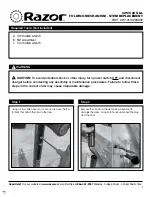
17
!
Forks
There are two different types of forks that vary in styles and dimensions. One type is a rigid
fork (Figure 1) consisting of stationary tubing with curved blades. The other type is a
suspension fork (Figure 2) consisting of inner stanchion tubes riding on elastomers or springs
inside of a straight outer fork leg. This mechanism acts as a shock absorber with a specified
amount of travel that varies between models. Some suspension forks are not adjustable and
are very difficult to disassemble. If service is needed on a suspension fork, consult a
professional bicycle repair technician
Your bicycle is equipped with a Suspension Fork as shown in figure 2
Do not attempt to disassemble a suspension fork yourself. Consult
X-Treme Scooters for assistance.
If your bike is equipped with a suspension fork, check that the fork compresses and rebounds
smoothly. To do this, place the fork dropouts against the ground, push and release the handle-
bar. The fork will generally compress 1-2” and rebound quickly. Most elastomer type forks
will gradually soften with use.
Fork
All manuals and user guides at all-guides.com
















































